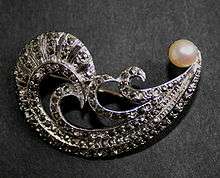Marcasite jewellery
| Marcasite | |
|---|---|
| Category | Mineral |
| Identification | |
| Color | Silver / Grey |
Etymology
Marcasite mär′ka-sīt an iron ore, a variety of pyrites (q.v.).

History
Marcasite jewelry has been made since the time of the Ancient Greeks.[1] It was particularly popular in the eighteenth century, the Victorian era and with Art Nouveau jewelry designers.[1][2]
When Prince Albert died in 1861 Queen Victoria entered a period of mourning, requiring her entire court to wear black and avoid opulent jewelry. Marcasite became popular as an understated alternative for the nobility.[3]
Geology
Marcasite jewelry is jewelry made from pyrite (fool's gold), not, as the name suggests, from marcasite.[4] Pyrite is similar to marcasite, but more stable and less brittle. It is frequently made by setting small pieces of pyrite into silver.[2] Cheaper costume jewelry is made by glueing pieces of pyrite rather than setting.[1] A similar-looking type of jewelry can be made from small pieces of cut steel.[1][4]
References
- 1 2 3 4 Goldemberg, Rose Leiman (2000). Antique Jewelry: A Practical & Passionate Guide. iUniverse. p. 116. ISBN 0-595-08898-8.
- 1 2 Hesse, Rayner W. (2007). Jewelrymaking Through History: An Encyclopedia. Greenwood Publishing Group. p. 15. ISBN 0-313-33507-9.
- ↑ Colonia Jewellery (2015). The Story Behind Marcasite Jewellery.
- 1 2 Thomas, Arthur (2008). Gemstones: Properties, Identification and Use. New Holland Publishers. p. 121. ISBN 1-84537-602-1.
| Wikimedia Commons has media related to Marcasite jewellery. |